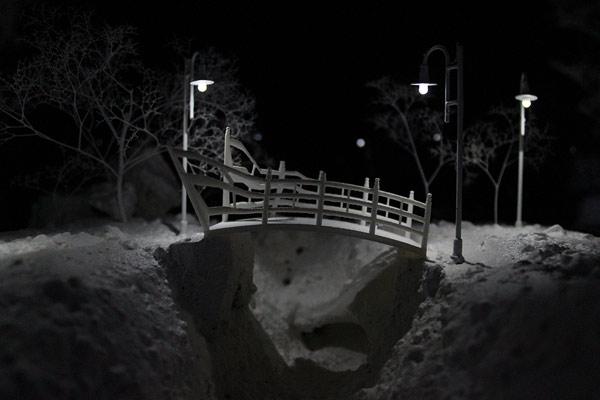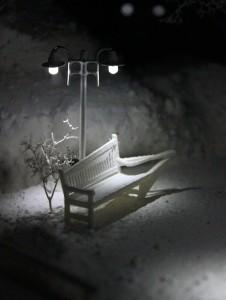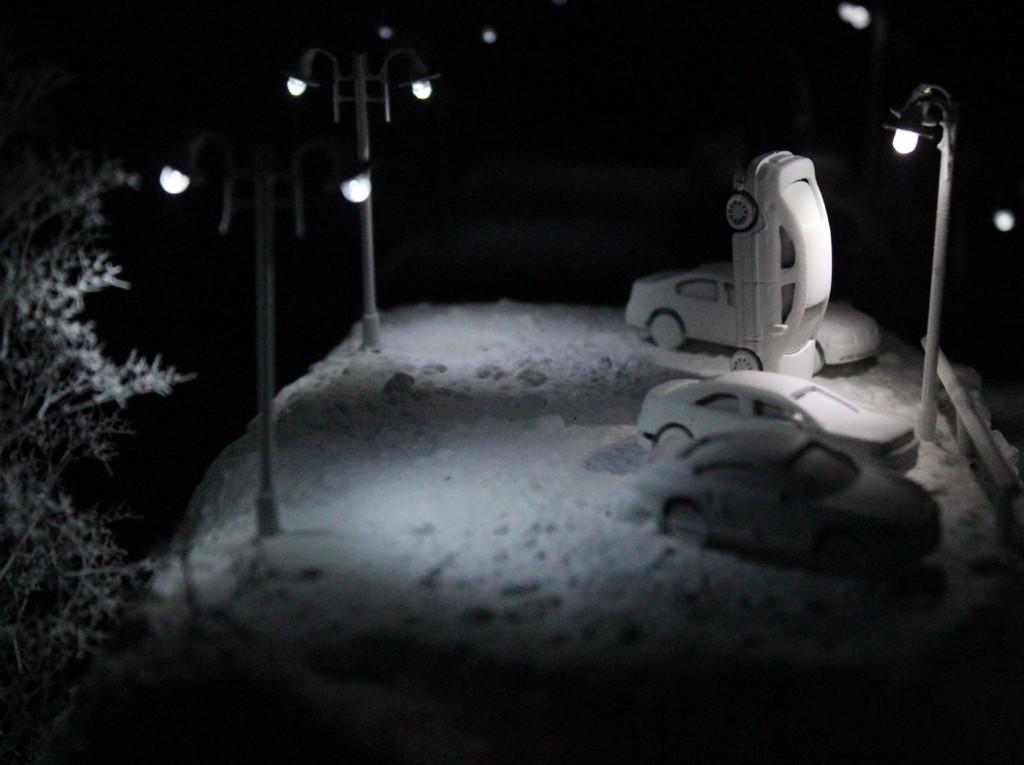Artist Mathieu Schmitt has 3D printed a magical and haunting landscape. His work, is what I imagine Bill Brandt’s imagery would be in 3D – absolute blacks and glimpses of a subtly distorted and emotionally charged landscape. Or possibly, it is more appropriate to compare his work to the photography of Jerry Uelsmann whose realism and misuse combined to create some of the most arresting work in the last 50 years. The comparison becomes even more engaging when considering the advanced tech of Schmitt and the manual composition of film images by Uelsmann.
Looking to photography to contextualize Schmitt’s work is particularly appropriate given the way that Schmitt utilizes light in order to create the image for his viewer. The dramatic and contrasty nature of what he shows result from the placement of his sculpture inside a smoked glass box that only allows 5% of light from the outside world to enter. Inside of this near light-vacuum, he places tiny street lamps, pinpointing light directed exactly as he wants you to see them and what they illuminate. It’s an additive method of lighting and could be described as 3D photography.
There is more to this work than just its unique and thought provoking final presentation. One of the signs that you have truly mastered a medium is the ability to use it incorrectly. Schmitt understands 3D design inside, outside, and upside down. The process by which the landscapes were produced required mis-feeding data or mishandling it to cause errors that modified and warped the models that Schmitt had created.
The subtle shifts in the geometry of familiar objects gives the work the feeling of uncertainty and impending doom utilized in the best Noir suspense films. The ‘mistakes’ are not immediately apparent, simply unsettling. It is only after getting much closer – and you are compelled to come closer, just like in all the horror movie clichés – that you start to be able to see what is wrong. As a result of the extreme shifts in dark and light, the forms emerge in their ghastly misshapenness only when you have completely engaged in the piece, making them all the more terrifying as they occupy your entire plane of vision.
 It is the fact that they are mundane objects only slightly askew that gives them this nightmarish quality. The stories that immediately begin to form in your mind to explain the way in which a car came to be stood upon its nose or the bulge developed at the back of a house, are all the more unnerving because there are no answers. This isn’t a titillating freak show, however, Schmitt isn’t trying to set you on edge with obvious scare tactics. It is this subtle approach that causes this piece to work its way under your skin even more, your brain keeps trying to ‘fix’ it and when it finds that none of this can be settled, sends a sense of unease through your body.
It is the fact that they are mundane objects only slightly askew that gives them this nightmarish quality. The stories that immediately begin to form in your mind to explain the way in which a car came to be stood upon its nose or the bulge developed at the back of a house, are all the more unnerving because there are no answers. This isn’t a titillating freak show, however, Schmitt isn’t trying to set you on edge with obvious scare tactics. It is this subtle approach that causes this piece to work its way under your skin even more, your brain keeps trying to ‘fix’ it and when it finds that none of this can be settled, sends a sense of unease through your body.
 The pieces have the glow of a landscape blanketed in snow and the stillness too. The arrested nature of the scenes is reminiscent of imagery of Pripyat, Ukraine, the city abandoned in the wake of the nuclear disaster at Chernobyl. Schmitt himself describes the nature of the scenes he has created:
The pieces have the glow of a landscape blanketed in snow and the stillness too. The arrested nature of the scenes is reminiscent of imagery of Pripyat, Ukraine, the city abandoned in the wake of the nuclear disaster at Chernobyl. Schmitt himself describes the nature of the scenes he has created:
“In each of the scenes from the set ‘Glitched,’ there is no evidence of movement or displacement, and no representation of any alive beings, which plunges it into a confused temporal setting, wedged between photography and cinematography.”
Schmitt’s approach was a reaction to the works of Austrian philosopher and scientist Heinz von Foerster who proposed that it was necessary to move beyond the perfection created by slavish usage of digital production. Instead, he advocated the possibilities inherent in warping the digital, thereby creating a new series of imperfections. After all, change is only possible when there are errors, whether small errors in the genetic code or a massive disturbance in atmospheric conditions. The key to combatting the finality of perfection therefore lies in glitches.
Let’s hear your thoughts on Schmitt’s 3D printed work, in the 3D printed nightmarish art forum thread on 3DPB.com.
Subscribe to Our Email Newsletter
Stay up-to-date on all the latest news from the 3D printing industry and receive information and offers from third party vendors.
You May Also Like
Nylon 3D Printed Parts Made More Functional with Coatings & Colors
Parts 3D printed from polyamide (PA, Nylon) 12 using powder bed fusion (PBF) are a mainstay in the additive manufacturing (AM) industry. While post-finishing processes have improved the porosity of...
3DPOD Episode 193: Flow and What’s Possible in 3D Printing with Ricky Wildman, University of Nottingham
Ricky Wildman is working on 3D printing pills, but, as Professor of Multiphase Flow and Physics at Nottingham, he does a whole lot more. His research encompasses the characterization of...
3D Printing Webinar and Event Roundup: March 17, 2024
It’s another busy week of webinars and events, including SALMED 2024 and AM Forum in Berlin. Stratasys continues its in-person training and is offering two webinars, ASTM is holding a...
3D Printed Micro Antenna is 15% Smaller and 6X Lighter
Horizon Microtechnologies has achieved success in creating a high-frequency D-Band horn antenna through micro 3D printing. However, this achievement did not rely solely on 3D printing; it involved a combination...































